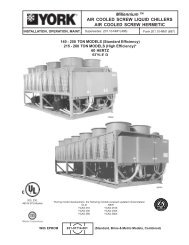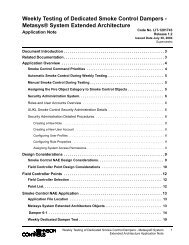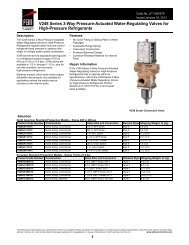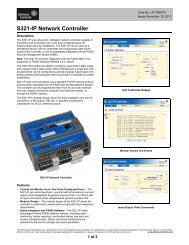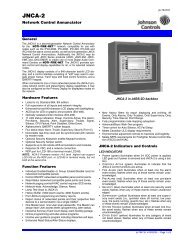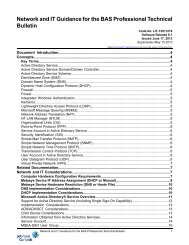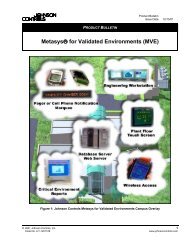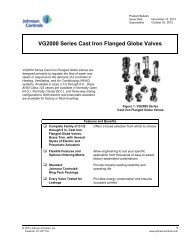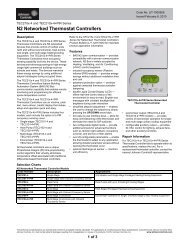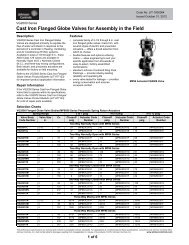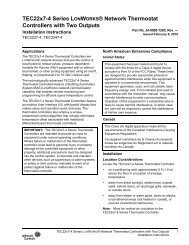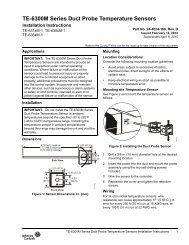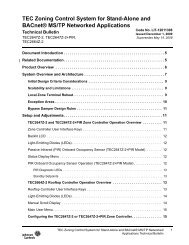YVAA Style A Air-Cooled Screw Liquid Chillers ... - Johnson Controls
YVAA Style A Air-Cooled Screw Liquid Chillers ... - Johnson Controls
YVAA Style A Air-Cooled Screw Liquid Chillers ... - Johnson Controls
Create successful ePaper yourself
Turn your PDF publications into a flip-book with our unique Google optimized e-Paper software.
SECTION 2 - PRODUCT DESCRIPTION<br />
lection allows configuration of the required equipment<br />
profile and output protocol, which reduces equipment<br />
connectivity startup time.<br />
MICROCOMPUTER CONTROL CENTER<br />
The microcomputer control center (see Figure 3 on<br />
Page 16) provides automatic control of chiller operation<br />
including compressor start/ stop and load/<br />
unload anti-recycle timers, condenser fans, evaporator<br />
pump, evaporator heater, unit alarm contacts and<br />
run signal contacts. The microcomputer control center<br />
comes online as soon as the main power switch on the<br />
unit is switched on; immediately, the microcomputer<br />
control center will begin to check all variables with a<br />
frequency ranging from 30 seconds to almost continuous<br />
monitoring.<br />
The microprocessor controls the unit’s capacity by<br />
matching the actual leaving chilled water temperature<br />
(LCWT) to the user-defined setpoint. Factors that<br />
may cause the system’s actual LCWT to fluctuate are<br />
changes in ambient temperature, loop flow rate, load,<br />
and loop volume. The control system reacts to such<br />
changes by adjusting the number of compressors that<br />
are on and the loading of each compressor in order to<br />
keep the LCWT at the setpoint.<br />
The control system logic monitors the rate at which the<br />
LCWT is approaching the setpoint to ramp up or down<br />
compressor capacity as required. The variable frequency<br />
drive allows the compressor capacity to match the<br />
load.<br />
Display Data<br />
16<br />
• Leaving Chilled <strong>Liquid</strong> Temperature<br />
• Returning <strong>Liquid</strong> Temperature<br />
• Ambient Temperature<br />
• Lead System<br />
• Compressor Capacity (% of Full Load Amps)<br />
• VSD Output Frequency / Compressor Speed<br />
• Compressor Run Hours<br />
• Compressor Number of Starts<br />
• Oil Pressure and Temperature (per Compressor)<br />
• Evaporator Pump Status<br />
• Evaporator Heater Status<br />
• History Data for Last Twenty Normal Shutdowns<br />
• History Data for Last Ten Shutdown Faults<br />
Programmable Setpoints<br />
• Chiller On/Off<br />
• Chilled <strong>Liquid</strong> (Water or Glycol)<br />
• Local or Remote Control<br />
• Units of Measure (Imperial or SI)<br />
• System Lead / Lag<br />
• Remote Temperature Reset<br />
• Remote Current Limit<br />
FORM 201.28-NM1.1<br />
ISSUE DATE: 8/29/2012<br />
• Leaving Chilled <strong>Liquid</strong> Temperature Setpoint and<br />
Range<br />
<strong>Johnson</strong> <strong>Controls</strong>’ systems or another vendor’s systems<br />
can incorporate these setpoints and data outputs to give<br />
the customer a complete understanding of how the system<br />
is running through a Building Automation System.<br />
Extreme Conditions - During extreme or unusual conditions<br />
(i.e. blocked condenser coils, ambient above<br />
scheduled maximum, etc.) the chiller control system<br />
will avoid shutdown by varying capacity. By monitoring<br />
motor current and suction and discharge pressures,<br />
the chiller can maintain maximum available cooling<br />
output without shutting down.<br />
FIGURE 3 - VIEW OF YORK CONTROL CENTER<br />
USER INTERFACE<br />
JOHNSON CONTROLS



